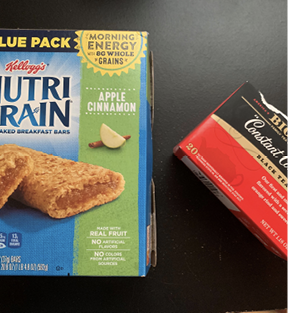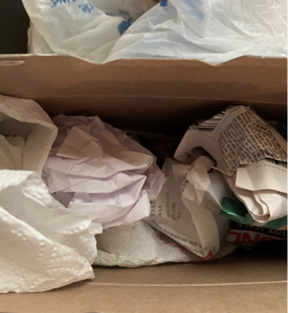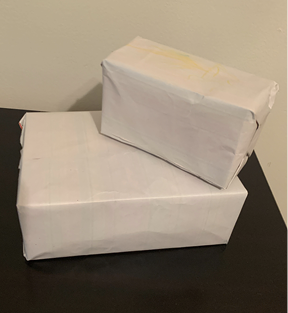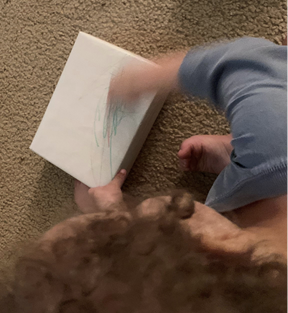Block Play
Playing with blocks includes creating, building, and experimenting with wooden, plastic, or cardboard blocks. Block play changes as your child gets older. They begin by carrying, piling, and laying blocks on the floor. They soon learn that they can connect blocks to create things such as bridges. Finally, your child will learn to make big constructions.
Younger children also use blocks for loading and unloading games, for stacking and knocking down, and as objects in pretend play. Older children use blocks to make tall buildings, roadways, and other things they see around them and to build structures for pretend play.
Children learn math concepts, solve problems, and develop physical and social skills when using blocks. There is no wrong way to use blocks. Children can explore and build in any way they want.
Block Center
Find a place for blocks that people do not have to walk through to get to other areas of the house. A corner away from doors works well.
Show interest in what your child does with blocks. Notice what your child builds with the blocks and talk with them about their block-building ideas.
Provide different types of blocks. Keep all of these organized in their own spaces and containers.
Have plenty of blocks so that your child’s imagination can take off. The more blocks that are available, the more creative they can be.
Put up pictures of real buildings to add interest and new ideas. Show pictures of buildings under construction.
Encourage long-term projects. Allow your child to come back and finish their building later.
Play with blocks outside.
Making Homemade Blocks
Materials
- used boxes like cereal boxes, tea boxes, card-board boxes, oatmeal boxes, pasta boxes, etc.
- newspaper
- scratch paper
- construction paper
- tape
- scissors
Instructions
Stuff empty boxes with newspaper or scratch paper. You may even use plastic bags or pages from an old magazine or junk mail. This will help keep the blocks stiff and more durable.
Once they are stuffed, tape the boxes closed.
If desired, you can wrap blocks with construction paper, wrapping the box like you would a present. You can also use wrapping paper or newspaper. Your child may also want to draw on the construction paper. (This may be easier to do before you wrap the box.)




Types of Blocks and Other Block Toys
- Wooden blocks (different sizes can be made from 2-by-4 pieces of lumber)
- Large cardboard boxes
- Oatmeal or cereal boxes
- Colorful plastic building blocks
- Put-together blocks
- Colored inch cubes
- Rubber blocks
- Foam blocks
- Bristle blocks
- Textured blocks (cover blocks of wood with fabrics of different textures)
- Lego bricks
- Lincoln logs
- Cloth-covered sponges
- Cloth or soft blocks
- Shoe box blocks
- ABC blocks
- Paper bag blocks (stuff lunch/grocery bags with newspaper; fold down the top and tape it closed; paint the bags red to look like bricks)
- Milk carton blocks
- Nesting blocks
- Small people
- Animals
- Little trucks
- Airplanes
- Trains
- Wooden or plastic houses
- Dollhouse furniture
- Miniature traffic signs
- Shells and seeds
- Telephone wire
- Empty paper towel rolls
- Bottle caps
- Airports
- Barns
- Gas stations
- Wagons
- Construction hats
- Construction toys
- Measuring tape
- Construction magazines/catalogs
- House plans or maps
- Paper, crayons, scissors
- Trees (from Lego sets)
- Play money
- Small containers
- Popsicle sticks
- Tiles, linoleum squares, rugs
- Pulleys and string
- Thin pieces of rubber tubing
- Egg carton or muffin tin to sort small toys
Activities Using Blocks
Infants
- Introduce your baby to block play in ways that suit their personality.
- Stay close when you’re first introducing blocks.
- Babies need soft, washable blocks that can be banged, dropped, mouthed, and cuddled.
- Build a tower of soft blocks with your baby. Let them knock the tower down. Keep doing this together for as long as the activity interests them.
- Drop a cardboard block to the floor from the air. As it lands, make a crashing sound such as “boom!”
- Encourage your baby to play with soft blocks in a space where they can bat at them undisturbed.
- Hold your baby in your lap and roll a large, colored block out in front of you. Try to use a block with a bell inside to catch the baby’s attention.
- Make a mobile of lightweight blocks of different sizes and colors. Hang the mobile where your baby can watch it move.
- Fill a container with small blocks and give it to your baby.
Toddlers
- Introduce toddlers to hard wood blocks before letting them play alone. Show how to stack blocks, match them, and so on.
- Provide wood or plastic people figures for block play. Ask a toddler, “Where do you think this mommy and daddy are going?”
- Bring toddlers together for block play.
- Provide construction items such as plastic hammers, pliers, measuring tapes, hats, and trucks for building fun.
- Give toddlers many opportunities to play with blocks on their own.
- Ask open-ended questions as your child plays, such as “What are you building with your blocks?” or “Which block are you going to use next?” Open-ended questions will encourage them to answer more than yes or no.
- Regularly add new props and materials to maintain your toddler’s interest.
- Provide a clear, unobstructed space for block play where your toddler can move about freely as they play.
- Show your toddler how to even a stack of blocks to keep it from toppling over.
- Fill empty tissue boxes with crumpled newspaper. Cover the hole in the boxes with a piece of cardboard. Cover the boxes with colored paper.
- Build a tower and hide behind it. Play peek-a-boo around the sides of it.
- Cover empty cereal or oatmeal boxes with paper. Let your child stack or roll them. You can also fill the containers with bells or sand to change their weight or sound.
- Build a tower with your child and, as the tower gets higher, help them reach to the top to stack more blocks.
- Read or tell a story about a train or put train pictures in the block area. Show your child how to put blocks in a row and then push it along the floor like a train.
- Cover a block with a larger one and let your toddler discover where it is.
- Put a piece of tape on the floor. Encourage your child to line the blocks up on the tape.
- Allow your child to play with blocks in the sandbox.
- Place several sturdy grocery/moving boxes in the block area. Put crumpled newspaper in the box and tape it shut.
- Provide two shapes of blocks such as triangles and rectangles. Ask your child to build two towers, one of triangles and one of rectangles.
- Encourage your child to match the different shapes that they see.
- Place surprise items in food boxes to explore.
- Put an object in a food box to make a noisemaker for your child to play with.
- Show the various ways to make a bridge, such as propping a rectangle on a square or by placing a rectangle on two squares at each end.
- Take pictures of your child playing with blocks and make a book out of the pictures.
- Build a garage made from blocks. Place a toy car in, on, over, and next to it, and ask your child where you placed it.
- Make a masking tape road on the floor or draw one on a shower curtain using a permanent marker. Encourage your child to make simple buildings along the roads.
- Count the number of blocks your child uses in a simple block structure.
- Ask your child to find different blocks as you describe them.
Preschool
- Provide your preschooler with block props that promote dramatic play, like people, animal figures, and cars and trucks.
- Have your child form numbers and letters from blocks. Provide written numbers and letters for them to look at.
- Challenge your child to use the blocks to build a home for your family.
- Make patterns using colored blocks or blocks of different shapes.
- Challenge your child to build structures using only rectangular blocks, triangular blocks, etc.
- Discuss opposites and encourage your child to build tall and short towers or wide and narrow towers.
- Make buildings that are the same. As your child builds with blocks, ask if you can try to match the blocks they use.
- Invite your child to build a wall with blocks. Provide plastic eggs and ask if they can balance the eggs on the wall like Humpty Dumpty.
- Your child can make animal cages using blocks to resemble a zoo. They can sort like animals into the cages.
- Encourage your child to build a castle or other pretend place using blocks.
- Build a home for each of the three little pigs and ask your child which home they would choose to live in.
- Challenge your child to construct large towers and bridges like the ones they see in picture books or magazines.
- Have your child put blocks in different orders: shortest to tallest, biggest to smallest, etc.
- Plan a walk in the neighborhood to look at buildings and roads.
Ask open-ended questions: “What can you tell me about your building?”
Sources
Albrecht, K., & Miller, L. G. (2000). The Comprehensive Infant Curriculum. Gryphon House, Inc.
Cryer, D., Harms, T., & Ray, A. R. (1996). The Active Learning Series. Addison-Wesley Publishing Company, Inc.
Dodge, D. T., & Cloker, L. J. (2001). The Creative Curriculum for Early Childhood. Teaching Strategies, Inc.
Dodge, D. T., & Cloker, L. J. (2001). The Creative Curriculum for Family Child Care. Teaching Strategies, Inc.
Schiller, P., & Phipps, P. (2002). The Complete Daily Curriculum for Early Childhood. Gryphon House, Inc.
The information given here is for educational purposes only. References to commercial products, trade names, or suppliers are made with the understanding that no endorsement is implied and that no discrimination against other products or suppliers is intended.
M2351By Louise Davis, PhD, Extension Professor, and Elizabeth Thorne, MS, Graduate Assistant, Human Sciences.
Copyright 2020 by Mississippi State University. All rights reserved. This publication may be copied and distributed without alteration for nonprofit educational purposes provided that credit is given to the Mississippi State University Extension Service.
The Mississippi State University Extension Service is working to ensure all web content is accessible to all users. If you need assistance accessing any of our content, please email the webteam or call 662-325-2262.

